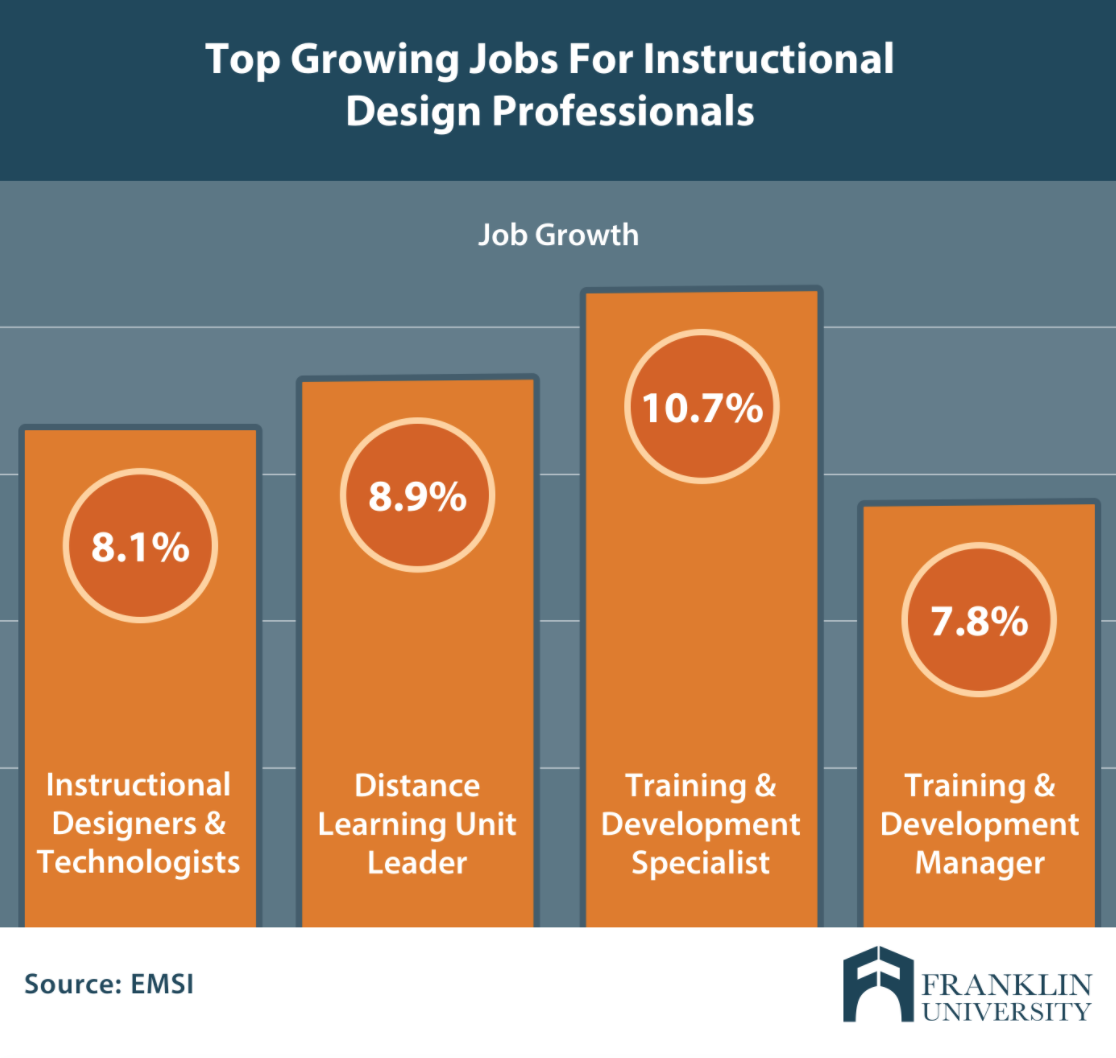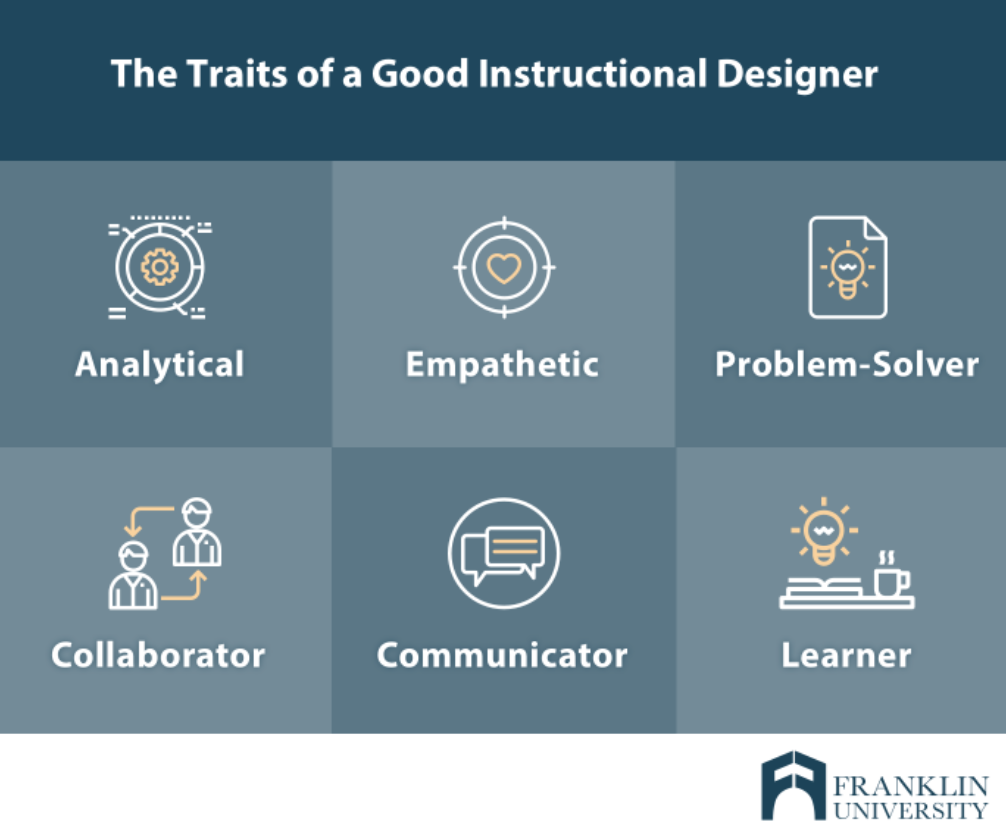Request Information
We're Sorry
There was an unexpected error with the form (your web browser was unable to retrieve some required data from our servers). This kind of error may occur if you have temporarily lost your internet connection. If you're able to verify that your internet connection is stable and the error persists, the Franklin University Help Desk is available to assist you at helpdesk@franklin.edu, 614.947.6682 (local), or 1.866.435.7006 (toll free).
Just a moment while we process your submission.

What is Instructional Design & What Career Options Exist?
As educational institutions and employers have quickly transitioned to remote learning and training environments, the need for instructional design is more apparent than ever. Taking in-person instruction and transitioning it to online learning is extremely challenging, which is why highly-skilled instructional designers are essential.
“Online learning is fundamentally different from in-person learning. The COVID-19 pandemic has shined a light on the need for dynamic online instruction. In order for online learning to be effective, the instructor needs to motivate students and the content needs to be engaging. Simply recording lectures and asking students to passively absorb information is not a successful model.”
Dr. Yi Yang,
Program Chair of the Master’s and Doctoral Programs in Instructional Design at Franklin University
While instructional design as a discipline has been around for decades, rapid shifts in technology and learning environments have accelerated the pace of change for this industry.
Why is Instructional Design Important and What Does It Involve?
Today, instructional design is at the forefront of the minds of educators, school systems, higher education institutions and employers. For well-qualified instructional designers, this is a pivotal moment for career growth and advancement.
Instructional design, at its core, aims to close the knowledge and skills gap of an audience through engaging learning experiences. Proper instructional design makes it easier, more effective and less time consuming to learn.
Instructional designers achieve these goals by using the basic components of instructional design:
- Research and analysis: Understanding learning goals, course content, audience needs, and technology requirements.
- Design and development: Designing course materials, determining delivery methods, and structuring curriculum.
- Assessment: Developing evaluations and determining when assessments take place to measure comprehension and skill development.
- Evolution: Using data to drive course improvements that improve learning outcomes.
What Does an Instructional Designer Do?
The majority of instructional designers create educational programs and training courses for institutions, organizations and corporations. While not all of these learning experiences are digital, for many instructional designers, online learning is a heavy focus area.

In the education industry, instructional designers aim to improve student outcomes—whether that’s more students passing a class, graduating from high school, or finding gainful employment upon earning their degree. Effective instructional design can also have other benefits, like increasing engagement, streamlining courses and reducing educational costs.
How does instructional design make a tangible impact in education settings? Instructional designers:
- Work with subject matter experts to understand course content and translate it effectively using tactics like games, videos, animations and exercises.
- Develop assessments at critical learning junctures to measure skill mastery, which can identify students who are struggling and help instructors proactively course correct.
- Transform in-person educational experiences to online learning courses that motivate and engage students.
In government and corporate settings, instructional designers make it easier for employees to gain required knowledge and skills. The benefits of implementing training programs developed by instructional design professionals include employee retention, increased job satisfaction, and long-term cost savings for the employer.
Thinking about applying for grad school? Get an inside look at how to create a winning admission essay with this free report.
How does instructional design make a tangible impact in employer settings? Instructional designers:
- Develop training programs that quickly onboard new employees to a culture and job, reducing their learning curve and increasing their productivity.
- Design programs to upskill employees, helping them advance their career while providing the company with much-needed skills (without additional hiring).
- Work with executives to identify skills gaps and align training programs with strategic business goals.
Where Can Instructional Designers Work?
While the education sector is a natural fit for instructional design professionals, you can work in nearly every industry. The diversity of career opportunities is evident when you look at the companies who have posted the most jobs for instructional designers over the past year (according to EMSI).
Want to work as an instructional designer? Here are ten of the top companies hiring.
- Pearson PLC (Multinational publishing and education company)
- Humana, Inc (Health insurance company)
- University of California (Higher education system)
- Johns Hopkins University (Top 10 university)
- United States Department of the Navy (Government)
- U.S. Bancorp (Banking and finance)
- Science Applications International Corporation (Information technology)
- IBM (International technology company)
- American Express Company (Financial services)
- Leidos Holdings, Inc (Scientific research)
6 Qualities of a Successful Instructional Designer
Instructional designers can hold a variety of different roles, requiring unique skill sets. However, there are common traits the most successful instructional designers possess.

To be a, effective instructional designer, it helps to be a(n):
- Analytical thinker: Effective learning solutions are data-driven. Being able to collect the right data, mine it for insights, and use those insights to improve your instructional design is essential to improving learning outcomes.
- Empathic instructor: You need to be able to empathize with your audience and put yourself in their shoes when creating learning experiences. By connecting with your audience on an emotional level, you’ll be able to not only understand their logical needs, but their intuitive learning preferences.
- Creative problem solver: With the fast pace of technological change, instructional designers need to be able to think outside the box to create innovative learning solutions. Imaginative, immersive learning environments are the future of instructional design.
- Strong communicator: You need to be able to effectively communicate in writing, verbally, and visually to be a well-rounded instructional designer. Understanding how people communicate differently, and the purpose of each style of communication, will help improve the experience you design.
- Effective collaborator: As an instructional designer, you will work with subject matter experts across a variety of disciplines. Working together to combine content with instructional format is a highly iterative process that requires true teamwork.
- Lifelong learner: In order to teach others, you need to love learning yourself. Being a passionate, avid learner who constantly seeks out new information and innovative ideas will position you for success.
Pathways to Becoming an Instructional Designer
While a bachelor’s degree may qualify you for an entry-level position in this field, most instructional design professionals hold a master’s or doctoral degree. This is because an advanced degree is usually required by higher education institutions and also preferred by many government and corporate employers.
Here are two of the top degrees that can help you excel as an instructional designer.
M.S. Instructional Design and Learning Technology
A master’s degree will teach you to analyze learning needs, design immersive learning solutions and evaluate the effectiveness of your solutions. This degree will prepare you to design educational and professional learning programs that help develop the knowledge and skills of workers.
Pro tip: Look for a degree that is aligned with industry best-practice standards, including the International Society for Performance Improvement (ISPI) and Association for Talent Development (ATD).
Doctor of Professional Studies in Instructional Design Leadership
A doctoral program will help you take your expertise to the next level to strategically impact businesses and educational institutions. This degree will help prepare you to work in higher education, corporate consulting and executive levels in the instructional design field.
Pro tip: Look for a flexible program that can be tailored to your specific research and curriculum interests, while also offering a streamlined dissertation process.
The Future of Instructional Design
Instructional design is an incredibly promising field with ample career opportunities. As automation increases, remote work becomes more prominent, and technology drives industries in new directions, instructional designers will be critical to maintaining a skilled workforce.
If you want to take advantage of this trajectory, Franklin University offers two instructional design degrees: M.S. Instructional Design and Learning Technology and Doctor of Professional Studies in Instructional Design Leadership. These programs are designed to help working professionals advance their career through a flexible, online degree that teaches in-demands skills. You will pair learning theory with practical applications to build your expertise and portfolio, preparing you for your next career move.





